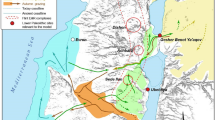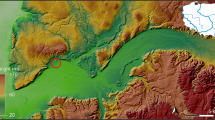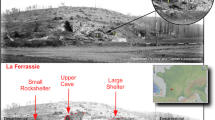Abstract
During new excavations at the preceramic rockshelter of Casita de Piedra in western Panama, a cache of 12 unusual stones was recovered near the back wall, dating to between 4800 and 4000 cal bp. The stones include quartz, pyrite, a chalcedony vein nodule, a bladed quartz and jarosite aggregate and a human-modified dacite cylinder. Based on the unusual lithic types and the context of the cache, we suggest that these stones once belonged to a ritual specialist, such as a healer or shaman. Special stones are frequently mentioned as being an important component of a shaman’s ritual paraphernalia in ethnographic records of various historic Native American groups throughout Central and South America, including the Bribri and Cabécar of southeastern Costa Rica and western Panama (formerly known as the ‘Talamanca’). The cache of stones recovered at Casita de Piedra may represent the earliest material evidence in Central America of shamanistic practice.








Similar content being viewed by others
Notes
The plant usually referred to as ‘maguey’, Agave americana, does not grow in western Panama naturally. It may have been cultivated, but it generally prefers much drier climates than exist in this region. Agave hurteri is the only species in the genus documented for the region (D'Arcy 1987).
References
Arriaga PJ d (1968 [1620]) The Extirpation of Idolatry in Peru (trans: Keating LC). University of Kentucky Press, Lexington
Baer G (1992) Matsigenka shamanism: the one intoxicated by tobacco. In: Matteson Langdon EJ, Baer G (eds) Portals of power. University of New Mexico, Albuquerque, pp 79–102
Barrantes Cartín C (2009) El último cacique: Talamanca, Siglo XIX. Editorial Universidad Estatal a Distancia (EUNED), San José
Barrantes R, Smouse PE, Mohrenweiser H, Gershowitz H, Azofeifa J, Arias T, Neel J (1990) Microevolution in lower Central America: genetic characterization of the Chibcha-speaking groups of Costa Rica and Panama, and a consensus taxonomy based on genetic and linguistic affinity. Am J Hum Genet 46(1):63
Blessing A (1921–1922) Apuntes sobre los indios Bribris de Costa Rica. Revista de Costa Rica 3 (4–5):99–101
Bozzoli de Wille ME (1977) Narraciones Bribris. Vínculos 3:67–104
Bozzoli de Wille ME (1979) El nacimiento y la muerte entre los Bribris. Editorial de la Universidad de Costa Rica, San José
Bozzoli de Wille ME (1982) Symbolic aspects of Bribri roles on the occassions of birth and death. In: Loveland CA, Loveland FO (eds) Sex roles and social change in native Lower Central American societies. University of Illinois, Chicago, pp 142–165
Brady JA, Prufer KM (1999) Caves and crystalmancy: evidence for the use of crystals in Ancient Maya Religion. J Anthropol Res 55(1):129–144
Carlson JB (1975) Lodestone compass: Chinese or Olmec Primacy?: multidisciplinary analysis of an Olmec hematite artifact from San Lorenzo, Veracruz, Mexico. Science 189(4205):753–760
Castillero-Calvo A (1995) Conquista, evangelización y resistencia: triunfo o fracaso de la política indigenista? Editorial Mariano Arosemena, Panama City
Cervantes Gamboa L (2003) Sounds like music: ritual speech events among the Bribri Indians of Costa Rica. Ph.D. dissertation, University of Texas, Austin
Constenla-Umaña A (1985) Los idiomas dorasque y chánguena y sus relaciones filogenéticas. Revista de Filología y Lingüística (Costa Rica) 2:81–92
Constenla-Umaña A (1991) Las lenguas del Área Intermedia: Introducción a su estudio areal. Editorial de la Universidad de Costa Rica, San José
Constenla-Umaña A (1995) Sobre el estudio diacrónico de las lenguas chibchenses y su contribución al conocimiento del pasado de sus hablantes. Boletín del Museo del Oro 38–39:13–56
Cooke RG (1989) The use of anurans for food by tropical Amerindians: archaeological and ethnographic evidence. ArchaeZoologia 3:133–142
Cooke RG (1998) The felidae in pre-Columbian Panama: a thematic approach to their imagery and symbolism. In: Saunders NJ (ed) Icons of power: feline symbolism in the Americas. Routledge, New York, pp 77–121
Cooke RG (2005) Prehistory of Native Americans on the Central American land-bridge: colonization, dispersal, and divergence. J Archaeol Res 13(2):129–187
Cooke RG, Sánchez LA, Udagawa K (2000) Contextualized goldwork from 'Gran Coclé', Panama: an update based on recent excavations and new radiocarbon dates for associated pottery styles. In: McEwan C (ed) Precolumbian gold: technology, style and iconography. British Museum Press, London, pp 154–176
Corbett G (2002) Epithermal Gold for Explorationists. Australian Institute of Geologists (AIG Online) Journal Paper 2002–2001 (April 2002):1–26
D'Arcy WG (1987) Flora of Panama checklist and index, part I: the introduction and checklist. Missouri Botanical Garden, St. Louis, Missouri
Davis EW, Yost JA (1983) Novel hallucinogens from Eastern Ecuador. Bot Mus Leafl Harv Univ 29(3):291–295
Dickau R (2005) Resource use, crop dispersals, and the transition to agriculture in Prehistoric Panama: evidence from starch grains and macroremains. Ph.D. dissertation, Temple University, Philadelphia
Dickau R (2010) Microbotanical and Macrobotanical evidence of plant use and the transition to agriculture in Panama. In: VanDerwarker AM, Peres TM (eds) Integrating zooarchaeology and paleoethnobotany: a consideration of issues, methods, and cases. Springer, New York, pp 99–134
Dickau R, Ranere AJ, Cooke RG (2007) Starch grain evidence for the preceramic dispersals of maize and root crops into tropical dry and humid forests of Panama. P Natl Acad Sci 104(9):3651–3656
Dobkin de Ríos M (1974) The influence of psychotropic flora and fauna on the Maya religion. Curr Anthropol 15:147–152
El-Seedi HR, De Smet PAGM, Beck O, Possnert G, Bruhn JG (2005) Prehistoric peyote use: alkaloid analysis and radiocarbon dating of archaeological specimens of Lophophora from Texas. J Ethnopharmacol 101(1):238–242
Eliade M (1964) Shamanism: archaic techniques of ecstasy. Pantheon, New York
Fock N (1963) Waiwai: religion and society of an Amazonian tribe. National Museum of Copenhagen, Copenhagen
Francfort HP, Hamayon RN (eds) (2001) The concept of shamanism: uses and abuses. Akademiai Kiad, Budapest
Furst PT (1972a) Flesh of the Gods: the ritual use of hallucinogens. Waveland Press, Prospect Heights
Furst PT (1972b) Symbolism and psychopharmacology: the toad as Earth Mother in Indian America. In: XII Mesa Redonda: Religión en Mesoamérica. Sociedad Mexicana de Antropología, Mexico D.F., pp. 37–46
Furst PT (1976) Hallucinogens and culture. Chandler and Sharp, Novato
Furst PT (1993) "I am Black Jaguar!": magical spells and shamanism of the Pemon of Southern Venezuela. In: Gossen GH (ed) South and Meso-American Native Spirituality. Crossroad, New York, pp 393–413
Gabb WM (1875) On the Indian tribes and languages of Costa Rica. Pro Am Philos Soc 14:483–602
Gillin J (1936) The Barama River Caribs of British Guiana. Papers of the Peabody Museum of American Archaeology and Ethnology 14. Harvard University, Boston
Glass-Coffin B (1999) Engendering Peruvian shamanism through time: Insights from ethnohistory and ethnography. Ethnohistory 46(2):205–238
Guevara-Berger M (1993) A Visit to a Bribri Shaman. In: Gossen GH (ed) South and Meso-American Native spirituality. Crossroad, New York, pp 371–390
Hill JD (1992) A musical aesthetic of ritual curing in the Northwest Amazon. In: Baer G, Matteson Langdon EJ (eds) Portals of Power. University of New Mexico, Albuquerque, pp 175–210
Haberland W (1961) Two shaman graves in Central America. Archaeology 14(3):154–160
Harner MJ (ed) (1973) Hallucinogens and shamanism. Oxford University Press, Oxford
Hayans G (1952) New Cuna myths, according to Guillermo Hayans (trans: Wassán H), vol 20. Etnologiska Studier, Etnografiska Museum
Hedenquist JW, Arribas A, Gonzalez-Urien E (2000) Exploration for epithermal gold deposits. Soc Econ Geol Rev 13:245–277
Hultkrantz A (1973) A definition of shamanism. Temenos 9:25–37
Guardia IGT (1988) Atlas Nacional de la República de Panamá. El Instituto, Panamá
Jara CV (1993) I ttè: Historias Bribris. Universidad de Costa Rica, San José
Jones PN (2006) Shamanism: an inquiry into the history of the scholarly use of the term in English-speaking North America. Anthropol Conscious 17:4–32
Joralemon D, Sharon D (1993) Sorcery and shamanism: curanderos and clients in Northern Peru. University of Utah Press, Salt Lake City
Karsten R (1935) The head-hunters of Western Amazonas: the life and culture of the Jibaro Indians of eastern Ecuador and Peru, vol VII, 1. Commentationes Humanarum Litterarum, Helsingfors
Kennedy AB (1982) Ecce Bufo: the toad in nature and in Olmec iconography. Curr Anthropol 23(3):273–290
Langdon EJM, Baer G (1992) Portals of power: shamanism in South America. University of New Mexico Press, Albuquerque
Lewis W, Kennelly E, Bass G, Wedner H, Elvin-Lewis M (1991) Ritualistic use of the holly Ilex guayusa by Amazonian Jivaro Indians. J Ethnopharmacol 33(1):25–30
Linares OF, Ranere AJ (1980) Defining the Problem. In: Linares OF, Ranere AJ (eds) Adaptive radiations in Prehistoric Panama. Peabody Museum Monographs No. 5. Peabody Museum of Archaeology and Ethnology, Harvard University, MA, pp 3–6
Lindgren W (1933) Mineral deposits, 4th edn. McGraw-Hill, New York
Loveland FO (1986) Jaguar metaphor of social control and authority in Rama Indian myth. In: Magaña E, Mason P (eds) Myth and the imaginary in the New World. FORIS Publications, Providence, RI
Lyman RL, O'Brien MJ (2001) The direct historical approach, analogical reasoning, and theory in Americanist archaeology. J Archeol Method Theory 8(4):303–342
Madsen W (1955) Shamanism in Mexico. Southwest J Anthropol 11(1):48–57
Martin RT (1970) The role of coca in the history, religion, and medicine of South American Indians. Econ Bot 24(4):422–438
Metraux A (1949) Religion and shamanism. In: Steward J (ed) Handbook of South American Indians, Volume 5: the comparative ethnology of South American Indians. Bureau of American Ethnology, Bulletin 143. Smithsonian Institution, Washington, DC, pp 559–599
Naranjo P (1995) Archaeology and psychoactive plants. Ethnobotany: evolution of a discipline. Dioscorides Press, Portland, pp 393–399
Perego UA, Lancioni H, Tribaldos M, Angerhofer N, Ekins JE, Olivieri A, Woodward SR, Pascale JM, Cooke R, Motta J (2012) Decrypting the mitochondrial gene pool of modern Panamanians. PLoS One 7(6):e38337
Price NS (2001) An archaeology of altered states: shamanism and material culture studies. In: Price NS (ed) The archaeology of shamanism. Routledge, New York, pp 3–16
Ramírez de Jara M, Pinzón Castaño C (1992) Sibundoy shamanism and popular culture in Colombia. In: Baer G (ed) Matteson Langdon EJ. Portals of Power. University of New Mexico, Albuquerque, pp 287–304
Ranere AJ (1975) Toolmaking and tool use among the preceramic peoples of Panama. In: Swanson E (ed) Lithic technology: making and using stone tools. Mouton, The Hague, pp. 173–209
Ranere AJ (1980a) Preceramic shelters in the Talamancan range. In: Linares OF, Ranere AJ (eds) Adaptive radiations in Prehistoric Panama. Peabody Museum Monographs, No. 5. Peabody Museum of Archaeology and Ethnology. Harvard University, Cambridge, pp 16–43
Ranere AJ (1980b) The Rio Chiriquí shelters: excavation and interpretation of the deposits. In: Linares OF, Ranere AJ (eds) Adaptive radiations in Prehistoric Panama. Peabody Museum Monographs, No. 5. Peabody Museum of Archaeology and Ethnology. Harvard University, Cambridge, pp 250–266
Ranere AJ (1980c) Stone tools and their interpretation. In: Linares OF, Ranere AJ (eds) Adaptive radiations in Prehistoric Panama. Peabody Museum Monographs, No. 5. Peabody Museum of Archaeology and Ethnology. Harvard University, Cambridge, pp 118–138
Ranere AJ (1980d) Stone tools from the Rio Chiriquí shelters. In: Linares OF, Ranere AJ (eds) Adaptive radiations in Prehistoric Panama. Peabody Museum Monographs, No. 5. Peabody Museum of Archaeology and Ethnology. Harvard University, Cambridge, pp 316–352
Ranere AJ (1992) Implements of change in the Holocene environments of panama. in: Ortiz-Troncoso OR, van der Hammen T (eds) Archaeology and environment in Latin America. IPP, Amsterdam, pp 25–44
Ranere AJ, Cooke RG (1996) Stone tools and cultural boundaries in Prehistoric Panama: an initial assessment. In: Lange FW (ed) Paths to Central American Prehistory. University Press of Colorado, Niwot, pp 49–77
Reich D, Patterson N, Campbell D, Tandon A, Mazieres S, Ray N, Parra MV, Rojas W, Duque C, Mesa N (2012) Reconstructing Native American population history. Nature 488(7411):370–374
Reichel-Dolmatoff G (1951) Los Kogi: Una tribu indígena de la Sierra Nevada de Santa Marta, vol 2. Iqueima, Bogata
Reichel-Dolmatoff G (1960) Notas etnográficas sobre los indios del Chocó. Rev Colomb Antropol 9:75–158
Reichel-Dolmatoff G (1971) Amazonian cosmos: the sexual and religious symbolism of the Tukano Indians. University of Chicago Press, Chicago
Reichel-Dolmatoff G (1975) The shaman and the jaguar: a study of narcotic drugs among the Indians of Colombia. Temple University Press, Philadelphia
Reichel-Dolmatoff G (1978) Beyond the Milky Way. Hallucinatory imagery of the Tukano Indians. UCLA Latin American Studies Series and Latin American Studies 42, pp. 1–160
Reichel-Dolmatoff G (1979) Desana shaman's rock crystals and the hexagonal universe. J Lat Am Lore 5(1):117–128
Reichel-Dolmatoff G (1985) Basketry as metaphor: a study of some arts and crafts of the Desana Indians of the Northwest Amazon. Musuem of Cultural History, University of California, Los Angeles
Reichel-Dolmatoff G (1987) Shamanism and art of the eastern Tukanoan Indians: Colombia Northwest Amazon. Section IX, Fascicle 1. Iconography of Religions. E.J Brill, Leiden
Reichel-Dolmatoff G (2006) Goldwork and shamanism: an iconographic study of the gold museum of the Banco De La Republica. Villegas Asociados, Colombia
Ryan R (2004) Shamanism in Costa Rica. In: Ethnobiology Costa Rica 2004. Report of the Organization for Tropical Studies Undergraduate Study Abroad Program. Available from: http://cro.ots.ac.cr/en/education/pdfs/usap/coursebooks/et04.pdf. Accessed 17 August 2010, pp. 197–206
Schultes RE (1972) Ilex guayusa from 500 a.d. to the present. In: Wassen SH (ed) A medicine-man's implements and plants in the Tiahuanacoid Tomb in Highland Bolvia, Etnologiska Studier, 32. Goteborgs Etnografiska Museum, Goteborg, pp 115–138
Schultes RE (1984) Fifteen years of study of psychoactive snuffs of South America: 1967–1982: a review. J Ethnopharmacol 11(1):17–32
Schultes RE (1998) Antiquity of the use of new world hallucinogens. Heffter Rev Psychedelic Res 1:1–7
Schultes RE, Hofmann A (1979) Plants of the gods: origins of hallucinogenic use. McGraw-Hill, New York
Schultes RE, von Reis S (eds) (1995) Ethnobotany: evolution of a discipline. Dioscorides Press, Portland
Sherratt AG (1995) Introduction: peculiar substances. In: Goodman J, Lovejoy PE, Sherratt AG (eds) Consuming habits: drugs in history and anthropology. Routledge, London, pp 1–10
Sherzer J (2004) Stories, myths, chants, and songs of the Kuna Indians. University of Texas Press, Austin
Sillitoe RH (2010) Porphyry copper systems. Econ Geol 105:3–41
Simmons SF, Christenson BW (1994) Origins of calcite in a boiling geothermal system. Am J Sci 294:361–400
Smith CE Jr (1980) Plant remains from the Chiriquí sites and Ancient vegetational patterns. In: Linares OF, Ranere AJ (eds) Adaptive radiations in Prehistoric Panama. Peabody Museum Monographs No. 5. Harvard University, Cambridge, pp 151–174
Stone DZ (1962) The Talamancan Tribes of Costa Rica, 43(2). Papers of the Peabody Museum of Archaeology and Ethnology. Harvard University, Cambridge
Sullivan LE (1988) Icanchu's dream: an orientation to meaning in South American Religion. MacMillan, New York
Torres CM, Repke D (2006) Anadenanthera: visionary plant of ancient South America. Haworth, Binghampton
Torres CM, Repke DB, Chan K, McKenna D, Llagostera A, Schultes RE (1991) Snuff powders from pre-Hispanic San Pedro de Atacama: chemical and contextual analysis. Curr Anthropol 32:640–649
Tosi JA, Jr. (1971) Inventariacion y Demonstarciones Forestales, Panama: Zonas de Vida. FO:SF/PAN 6: Informe Técnico 2, Programa de las Naciones Unidas para el Desarrollo, Panama
Valcárcel LE (1964) Historia del Perú antiguo. Editorial Juan Mejía Baca, Lima
VanPool CS (2009) The signs of the sacred: identifying shamans using archaeological evidence. J Anthropol Archaeol 28:177–190
Velásquez R (2004) The fundamental role of music in the life of two Central American ethnic nations: The Mískito in Honduras and Nicaragua, and the Kuna in Panama. In: Kuss M (ed) Music in Latin America and the Caribbean: an encyclopedic history, vol 1. University of Texas Press, Austin, pp 193–230
Vitebsky P (2001) Shamanism. University of Oklahoma Press, Norman
Weaver MP (1981) The Aztecs, Maya and their predecessors, 2nd edn. Academic Press, New York
Weil AT, Davis W (1994) Bufo alvarius: a potent hallucinogen of animal origin. J Ethnopharmacol 41(1):1–8
Whitten NE Jr (1978) Ecological imagery and cultural adaptability: the Canelos Quichua of Eastern Ecuador. Am Anthropol 80(4):836–859
Wilbert J (1979) Magico-religious use of tobacco among South American Indians. In: Browman DL, Schwarz RA (eds) Spirits, shamans, and stars: perspectives from South America. Mouton, The Hague, pp 13–38
Wilbert J (1993) Tobacco and shamanism in South America. Yale University Press, New Haven
Willey GR (1953) What archaeologists want. In: Tax S, Eisley LC, Rouse I, Voegelin CF (eds) An appraisal of anthropology today. University of Chicago Press, Chicago, pp 229–230
Willey GR, Sabloff JA (1993) A history of American archaeology, 3rd edn. WH Freeman, New York
Winkelman MJ (1990) Shamans and other "magico-religious" healers: a cross-cultural study of their origins, nature, and social transformations. Ethos 18(3):308–352
Young P (1971) Ngawbé: tradition and change among the Western Guaymí. Illinois studies in anthropology 7. University of Illinois Press, Urbana
Acknowledgments
Funding was provided by the Social Sciences and Humanities Research Council of Canada (SSHRC). The communities of Casita de Piedra and Quebrada Seca, Chiriquí, Panama, generously provided hospitality and help during excavation. Fieldwork and permits were facilitated by the Smithsonian Tropical Research Institute, Panama, and the Departmento del Patrimonio Histórico of the Instituto Nacional de Cultura, Panama. Lab and logistical support was provided by the Department of Archaeology, University of Calgary. We owe a great debt of gratitude to Anthony J. Ranere for his insights, guidance, and excavation assistance. Thanks to Eduardo Bejerano and Drude Molbo for field assistance, Sonia Zarillo and Scott Raymond at the University of Calgary for helpful discussions, and Yvonne Kjorlien for comments on the manuscript. Initial observations and comments on the cache stones were made by members of the Geology Department at the University of Calgary. We thank two anonymous reviewers for their constructive comments.
Author information
Authors and Affiliations
Corresponding author
Rights and permissions
About this article
Cite this article
Dickau, R., Redwood, S.D. & Cooke, R.G. A 4,000-year-old shaman’s stone cache at Casita de Piedra, western Panama. Archaeol Anthropol Sci 5, 331–349 (2013). https://doi.org/10.1007/s12520-012-0112-5
Received:
Accepted:
Published:
Issue Date:
DOI: https://doi.org/10.1007/s12520-012-0112-5




